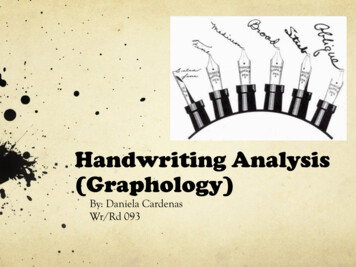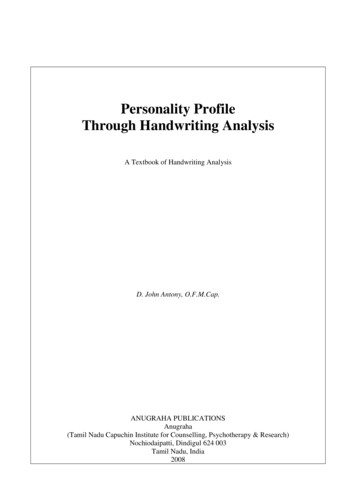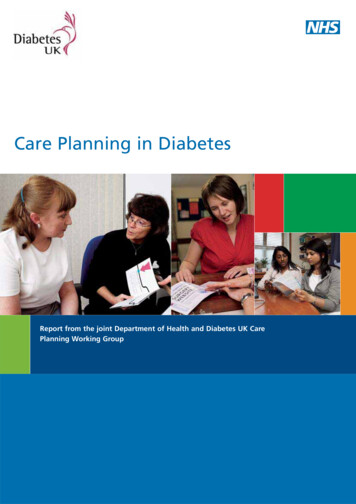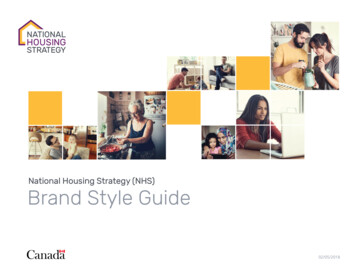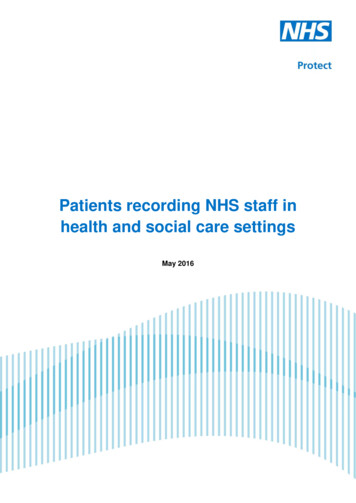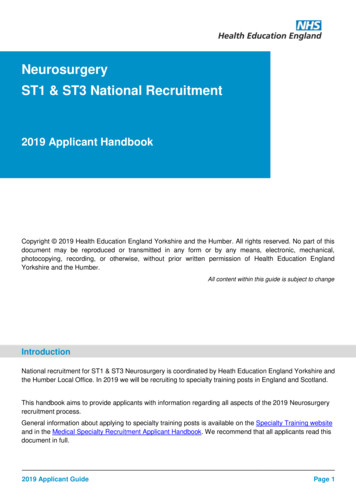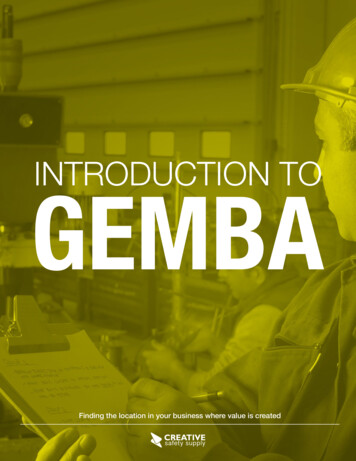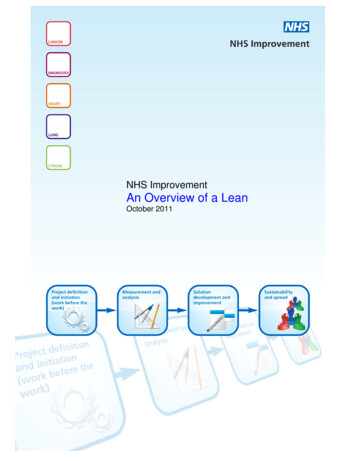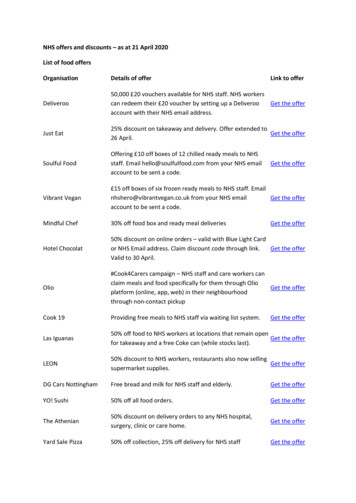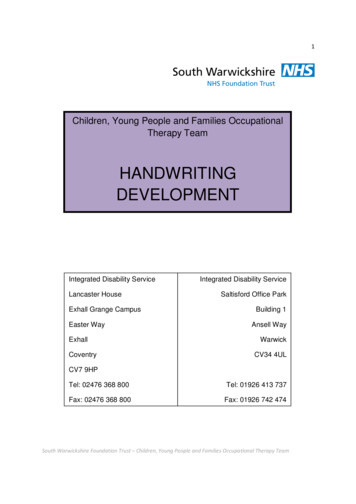
Transcription
1Children, Young People and Families OccupationalTherapy TeamHANDWRITINGDEVELOPMENTIntegrated Disability ServiceLancaster HouseExhall Grange CampusEaster WayExhallCoventryIntegrated Disability ServiceSaltisford Office ParkBuilding 1Ansell WayWarwickCV34 4ULCV7 9HPTel: 02476 368 800Tel: 01926 413 737Fax: 02476 368 800Fax: 01926 742 474South Warwickshire Foundation Trust – Children, Young People and Families Occupational Therapy Team
2ContentsContentsPage Number2Pre-Writing Skills3Development of Postural Control3Activities to Develop Postural Control5Development of Grasp & Fine Motor Skills6Activities to Develop Grasp & Fine Motor Skills7Development of a Tripod Grasp8Activities to Develop a Tripod Grasp9Development of Letter Formation10Activities to Develop Visual Motor Integration & Copying of Basic11Pre Writing ShapesEarly Writing SkillsSetting Up Good Working Positions in the ClassroomStarting LettersFluency & Speed12-131415-1617Improving Legibility18-19Pressure & Hand Fatigue20-21Helpful Hints on Handwriting22-24Left Handedness – Handwriting grip & Arm position25-26Handwriting Tips for Older Children27-28Writing Activities for Older Children29Multi Sensory Teaching Procedure – Sidney Chu 200330References31Further Reading & Resources32Equipment33Printables34Letter Groups35South Warwickshire Foundation Trust – Children, Young People and Families Occupational Therapy Team
3Pre-writing SkillsDevelopment of Postural ControlIn order to write, a child needs to be able to maintain their own balance in sitting withoutusing their hands. They need to have good control of their trunk and shoulder musclesand be able to reach forward in a controlled way.Firstly, the child should have access to a chair and table of the correct height or theirability to stabilise themselves for writing will be compromised.When sitting on a chair, the child’s feet should be flat on theground, their bottom should be right back in the seat and theirknees and hips should be bent to approximately 90º.The desk should be just above the height of the child’selbows.Even with the correct sized chair and table, a child with poorpostural control may: Fidget constantly Wrap their feet around the legs of the chair Slide forward in their seat Lean to the side Lean forwards onto the desk or even rest their heads on the desk Use their arms to prop themselves up Keep their arms pressed tightly into their sides.Things to be aware of If your child bends over their work or leans their head on the table, you could askthe school to try a slope board or sloping desk to help him/her stay upright. Thiswill also help with wrist position. Check the child’s position in the classroom. The child should be close to thefront, facing forwards to help with looking at the teacher and the board.South Warwickshire Foundation Trust – Children, Young People and Families Occupational Therapy Team
4 The page or book should be tilted rather than straight on in front of the child. Fora right-hander the page should be closer to their right arm and the top should betilted to the left. It should be opposite to this for a left-hander with even more tilt.Paper Position for Right-HandersPaper Position for Left-HandersSouth Warwickshire Foundation Trust – Children, Young People and Families Occupational Therapy Team
5Activities to develop Postural Control Playing on playground equipment such as swings, climbing frames and merrygo-rounds Construct obstacle courses that require crawling and climbing Play ‘Twister’ or ‘Simon Says’ (using odd body parts such as standing on oneleg, or balancing on one foot and one hand) Play with balls or beanbags whilst the child is sitting, kneeling,half-kneeling, squatting and standing Jumping on a trampoline Dancing: either at home or dance classes Play tug-of-war Kicking a ball in the back garden or park Skateboarding Martial Arts such as Tai Chi, Tae Kwon-do, or Karate Swimming, Gymnastics or organised play gyms Play “What’s the time Mr Wolf?” where the child has to stopquickly and not move Encourage the child to complete activities that involve leaning on their arms andputting weight through their arms and shoulders, for example, completing puzzlesin side sitting Roll out dough/pastry with a rolling pin Press cutter shapes into a dough Hand prints/potato prints/sponge painting etc Wiping tables, cleaning windows with straight arms Painting on an easel/paper pinned to wall Wall press-ups or chair push-ups.South Warwickshire Foundation Trust – Children, Young People and Families Occupational Therapy Team
6Development of Grasp and Fine Motor SkillsA child needs to have well-developed hand use, grasps and fine motor skills in order tocontrol a pencil accurately. Check to see whether the child is able to: grasp objects with their whole hand manipulate objects such as turning them over, moving them around in theirfingers using one hand and two hands together pick up small objects using a pincer grip (tips of thumb and index finger) pick up objects or manipulate them using a tripod grip (thumb, index and middlefingers) use co-ordinated fine motor skills during play.If the child struggles with any of these areas, please refer to the Children, Young Peopleand Families Occupational Therapy Team’s Fine Motor Booklet.South Warwickshire Foundation Trust – Children, Young People and Families Occupational Therapy Team
7Activities to Develop Grasp and Fine Motor Skills Building blocks Pegboard activities Lacing or threading activities Using tweezers or tongs to pick up small objects Craft activities, including collages, paper mache, glueingand cutting Card games Puzzles Games such as checkers, pick-up sticks, marbles, jacks Family games such as Jenga, Kerplunk, Operation, Tumbling Monkeys, WigglyWorms Lego, Duplo, K’nex and other construction toys Keyboard activities (computer or piano) Playing with spring-loaded pegs Origami Weaving Finger painting Dressing up using clothes with buttons, press-studs, zips andshoelaces Playing with playdough Mixing ingredients and helping during cooking.South Warwickshire Foundation Trust – Children, Young People and Families Occupational Therapy Team
8Development of a Tripod GraspEven when a child has good fine motor skills and well-developed grasp patterns,holding a pencil is a new and complex task. You may need to check the child’s grip onthe pencil while they are colouring or drawing. The pictures below show thedevelopmental stages that a child may go through when learning to hold a pen.1-1½ years2-3 years3½-4 years4½-6 yearsPalmar SupinateGraspDigital PronateGraspStatic Tripod GraspDynamic TripodGrasp(Erhardt, 1994)A child should be able to use a static or dynamic tripod grasp for writing. This meansthat: the pencil is held between the tips of the thumb, index and middle fingers the pencil is held in a relaxed way without too much pressure on the shaft of thepencil the pencil rests on the hand between the thumb and index finger (webspace) the webspace gap should be open (ie the thumb and index fingers form a circle) the ring and little fingers are held away from the pencil bent slightly into the palm.It is important to encourage the child to hold the pencil using a dynamic tripod grip.If your child does not use this grip, you could try using a Pencil Grip, such as the SoftPencil Grip as these may help your child to develop the correct grip.Fine motor activities will help to strengthen your child’s hand muscles and help todevelop a tripod grip, such as tiddlywinks, sorting coins, playing Connect Four. Pleaserefer to the Children, Young People and Families Occupational Therapy Teams FineMotor Booklet for more information.South Warwickshire Foundation Trust – Children, Young People and Families Occupational Therapy Team
9Activities to Develop a Tripod Grasp Placing clothes pegs/bulldog clips around the edge of a container Picking up small objects using tongs and then tweezers Threading beads Picking up cards Fill a medicine dropper (or mini turkey baster) with paintand drop onto paper Playing with squirt gun or squirt bottles with a triggeraction. Drawing on a brick wall with chalk and then using a squirter and water toremove the chalk marks. Posting coins into a box with a slot in the lid During craft activities, use stickers or mini stampers, holding with the thumb,index and middle fingers only Transfer water from one container to another using a turkey baster Popping bubble wrap Placing pegs in and out of a pegboard Making paper clip chains Playdough modeling Playing with construction toys such as Lego Use felt-tips and crayons that are thicker and shorter. Very short crayons cannotbe held with a whole hand grasp Ask the child to hold a small sponge or eraser in their hand with their little andring fingers and then hold a pencil with the other fingers Use a moulded pencil grip to help the child position their fingers on the pencil,such as The Soft Pencil Grip.South Warwickshire Foundation Trust – Children, Young People and Families Occupational Therapy Team
10Development of Letter FormationLetter formation is part of the development of fluent handwriting and forms thefoundation for joining letters in the later school years. It needs to become automatic sothe child can concentrate on the content of their writing rather than having to use a lot ofenergy on how to write the letters. Lots of practice is the best way to help letterformation become automatic.A child should learn to copy basic pre-writing patterns and shapes.Beery (1997) proposed that a child will be ready for formal instruction in handwriting ifthey manage to master the first 8 figures of the Developmental Test of Visual-MotorIntegration (VMI).Focus on precision of the following shapes:South Warwickshire Foundation Trust – Children, Young People and Families Occupational Therapy Team
11Activities to Develop Visual Motor Integration and Copying of BasicPre-writing ShapesDeveloping Copying Skills Copy patterns using building blocks, matchsticks, coins, buttons, pegboards.Make it harder by taking away the original and asking the child to copy it frommemory Copy basic shapes and patterns using playdough, drawing in sand, usingpipecleaners Mazes Tracing activities.Developing Copying of Pre-Writing ShapesUse the pre-writing shapes (above) for the following activities: Walk along a rope, string, or taped line Follow-the-leader in different shapes Making your own body look like the different shapes Finger painting with shaving cream, paint, cornflour and water Sand drawing with sticks, fingers, rakes, spades or even feet Make the shapes out of pipe cleaners, Wikkistiks or string Water painting on a brick wall using a paintbrush or a squirter bottle Tracing with stencils using finger paints, marker pens or crayons Join the stars/stickers to make the shapes Drawing in the air with a ribbon stick or wand Games with matching the different shapes Use an upright chalkboard or paper pinned to a wall.South Warwickshire Foundation Trust – Children, Young People and Families Occupational Therapy Team
12Early Writing SkillsThese ideas are helpful for children who have difficulties withshape drawing and writing patterns. They will help children toreach information through another channel, they are fun andchildren may not know that they are ‘working’.Always try to teach these skills by starting with largemovements before small ones. For example, practicedrawing a large circle on the blackboard or large piece ofpaper taped to the wall before attempting it with paper andpencil at the table. Secondly, you should try to involve asmany of the other senses as possible.To learn new or difficult shapes and letters follow this progression:1. Have the child trace the shape first, either on top of the shape with his/her fingeror in a different texture e.g. sandpaper letters. Then progress to using a pencil totrace over the shape.2. Once he can trace competently, use dots for him/her to ‘target’ while doing theshape.3. The next step is to draw the shape after watching a demonstration first(imitating).4. Copying is the last step, where the child can copy a shape from a model withoutdemonstration.To make learning fun and to involve multiple senses, try the following:1. Use a variety of tools: Wax crayons, thick and thinChalk on paper or blackboardFelt tip pensPaint with brushes, fingers, sponge pieces, rollers, etc.Fingers in shaving foam wet sand, flour, etc.Shaving Foam.2. Use a variety of surfaces: Paper – white, coloured, blackBlackboardShiny cardTextured wall papersTracing paperPaper over textured surfaces – corrugated card, sand paper, coins, etc.South Warwickshire Foundation Trust – Children, Young People and Families Occupational Therapy Team
133. Use a variety of positions: Sitting at a tableStanding at a tableVertical easelLarge sheets of paper stuck to a wallStanding or kneelingOn all four’s working on the floor, weight bearing throughnon-dominant hand using paper flat on the floor.4. Other fun ideas: Write letter on another person’s back with a finger and guess what the shape is Practice letters in the air with large arm and hand movements – can be practicedwith 2 hands together or one arm at a time Attach a piece of ribbon to a stick or use a torch and ‘draw’ letters in the air Use finger paints or shaving foam with rice or other materials added to give extratexture – use whole hands then individual fingers, e.g. large circular motions,vertical, horizontal and zig-zag lines Make letters and shapes with play dough – encourage the child to feel the shapeand trace its outline with their fingers Pastry or biscuit mixture – make shapes and bake them Star tracking: put stick-on stars onto a large piece of paper at the beginnings,end or corners of a shape and encourage the child to draw from star to star tomake the shape Use a plastic bottle with wate
Playing with squirt gun or squirt bottles with a trigger action. Drawing on a brick wall with chalk and then using a squirter and water to remove the chalk marks. Posting coins into a box with a slot in the lid During craft activities, use stickers or mini stampers, holding with the thumb, index and middle fingers only
